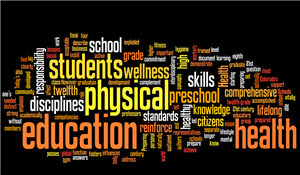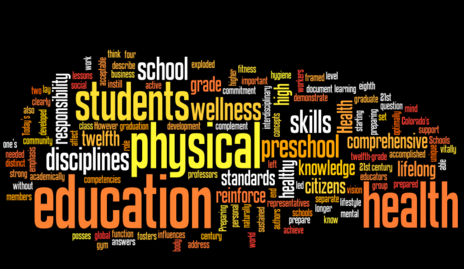|
Balance Tag: Two taggers are chosen and are given gator balls to use to tag the other students as they move around the gym. Players may stay on a safe zone (poly spot) if they can balance on the correct foot, such as — orange spot – left foot balance; blue spot – right foot balance. The students must move off the spot if they put their foot down or if they rest the foot on top of the balanced foot. Players who are tagged are required to perform a certain task. When the task is completed, the player can return to the game.
Circuit Training: Set up various exercise stations in the gym. Place students in same number of groups, as there are stations. Place groups at a station. On the command “Go!” The students will perform the exercise at there station. After 45 seconds have groups switch stations until they have completed the entire circuit.
Class exercises: Students will be stay in their homes. Students will perform various teacher led exercises. Exercises may include jumping jacks, sit-ups, pushups, ski jumps, arm circles, and other various exercises and stretches.
Countdown Stations: Set up exercise stations in each corner of the gym. All players begin at station one. Students must perform the exercise posted at station one and then jog 4 laps. They then move to station two and perform the required exercise; plus jog 3 laps. Students will then go to the third station and continue to count down to one lap.
Exercise Cards: Many different exercises are posted on a set of 3X5 cards. As the students enter the gym have them draw a recommended number of cards. After they have drawn their cards they must go to their home spaces and complete the exercises on their cards.
Exercise Tag: Two students are chosen to be it. On the signal, the It’s try to tag the other students. If the students get tagged they must come to the center circle and perform an exercise assigned by the teacher. Once they complete the exercise they may return to the game.
Exer-dice: In this activity the students roll one foam die to determine the exercises they perform. Post a list of six exercises on the gym wall and correlate them with the dice numbers. For example a students rolling a six may have to do 25 jumping jacks for rolling the six. They perform the exercises in their home then come back to the line. Each student will get 4 turns.
“Fit”-tionary: Divide the class into six groups. Place exercise cards face down opposite each group. Take turns running down picking up a card, placing the card in another pile. Run back to the group, without talking draw the exercise. When the team guesses the correct exercise everyone in the group does 15 of the exercise.
Four-corner Cartoon Traveling: To begin show students how each corner of the gym has a picture of a cartoon character. Let them know that when the music begins, they will be moving around the gym using a specific locomotor movement that you call out (skip, jog, gallop, etc.) When the music stops, they are to safely move to one of the four corners and wait there until you pick one of the exercise cards from your hand. The students standing by the picked character card must do a chosen exercise. Continue until song is complete.
Jogging: Have the students jog a teacher determined number of laps. Encourage the students to pace themselves.
Jump roping: Have the students jump for a certain length of time. Students should jump the rope in their home space and they may experiment with different styles of rope jumping. Use music to increase the enjoyment.
Jumping: Students will work in pairs. Designate one partner as partner A and the other partner as partners B. Students will face each other and jump up and down together 6 times. On the sixth jump, each student will place either their left or right leg out. If the students have opposite legs out Partner A gets a point if the students have the same leg out Partner B gets a point. Play to 10 points and begin again.
Mat-ercise: Each student is supplied a mat to take back to their home space. Have students perform various exercises on the mat. Use sit-ups, push-ups, and stretching activities. Also have them build bridges over the mat.
On the Bank – In the River: Line students up behind a line. When you say “in the river”, they jump across the line. When you say, “on the bank”, jump backward across the line. If you catch a mistake, or they are the last one, they go back to the next line on the gym floor and keep on playing after they do 5 push-ups, jumping jacks, or crunches. Keep playing until last one on the original line is still there.
Partner Duck, Duck, Goose: Start by placing the children in pairs. Each partner faces the other about two to three feet apart; close enough to be able to touch each other with a hand. Mark a safety line off about 20 to 30 feet behind each player. Each player takes turns tapping the other on the shoulder and saying either “duck or goose”. When a player says “duck” nothing happens. When a player says “goose” he or she turns and runs to the safety line while the other player chases. If the chaser tags the runner before the runner reaches the safety line, the chaser wins the turn and they return to the starting area for another turn. If the runner makes it to the safety line without being tagged, the runner wins the turn and a new game is started.
Partner Tasks: Students will work in pairs. Each partner will line up on the sidelines across from each other. They will be given different tasks to do. For each task they are given they will run to the middle and meet and perform the task together. Example: 1) give each other a high five 2) give each other a low five 3) give each other a sole five 4) do 10 jumping jacks 5) do 10 pushups 6) do 10 ski-jumps.
Playing Card Warm-up: As the students enter the gym they go to the middle circle and draw 2-3 cards from the pile. They will then match the number/letter on the card with the numbers on the posters and perform the exercise posted.
Playing Card Warm-up II: As the students enter the gym they go to the middle circle and draw one playing card from the pile (two decks with 2’s, 3’s, & 4’s removed). They match the suit of the playing card to one of the four posters in the corners of the gym and go to that corner. The posters tell them what activity to perform and the number on the playing card tells them the number of repetitions. When completed, he/she goes back to the center of the gym to get another card. Picture cards count as 10 and aces are 11. When the students complete five cards, they sit in their homes.
Pushup Fun: Students will work in pairs. Have students either side by side or facing each other approximately 1 foot apart. Pushup tag: One person begins as “it” and attempts to tag their partner on the hand while remaining in pushup position. You can only move your hands not your whole body. “It” person is constantly changing. High Five pushups: Partners will proceed to give each other a high five with the left hand and then the right hand while remaining in pushup position. They will continue this pattern for 1-2 minutes.
Stretching: Have the students perform various stretches in their home space. Be sure to stretch each area of the body. The teacher should lead the activity.
Tag Team Running: Each student will pick a partner. While #1 partner is running a lap, #2 is performing a specific exercise. When #1 finishes running, he/she tags his/her partner and they switch roles. The students will run a total of 2-3 laps and do 2-3 different exercises
Trading Cards: Equipment: a number of different colored cards & colored wallstops.
Give each student a colored card. Students move throughout the gym, switching cards. After 45-60 seconds give them the signal to stop and whatever color card they are holding will determine which wallstop to go to. If a student has a red card they go to the red wallstop and pick and exercise from the list to perform. After a certain time, signal them to begin moving and switching cards again.
Tug of War: Divide the class into evenly matched teams. Have the rope going across the length of the gym. The team in which has their anchor touch the red mat first is the winner. Be sure to switch teams around so everyone has a chance to be on a winning team. |


